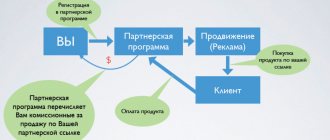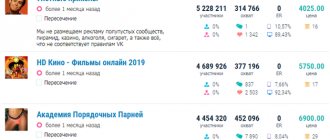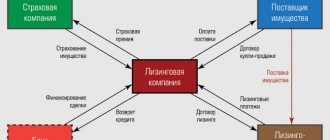Basics → Studying and working with consumers → What is important to know about the target audience?
The target audience of a product (from English target audience, target group) is a specific group of people to whom all marketing communications of the brand are directed. The target audience includes not only existing buyers of the company's product, but also potential consumers, whose attraction is important for gaining a stable position in the industry.
In this article we will look at the basic principles of working with the company’s target audience; we will tell you about the existing types of target audience; We’ll tell you how to determine the core of the target audience; and provide a detailed list of characteristics that can be used to describe the target audience of any company.
Basic principles of working with the target audience
A company's target audience is an important aspect of any marketing activity. Having a target audience for a product allows you to concentrate on a specific group of market consumers and create the ideal product for them, selling it in the place they need with the right communication. The target audience defines the boundaries of the company's target market and is determined using special marketing research. In fact, the target audience is the group of people who need your product and are interested in the benefits offered by the product.
The target audience of a product is a specific consumer market segment or a group of such segments; accordingly, any target audience is characterized by signs and characteristics that are common to each of its representatives. And it depends on you by what criteria you unite consumers into the target audience:
- by geographical: for example, the target audience is residents of Eastern Europe;
- by socio-demographic: for example, the target audience is women aged 20-30 with an average income, occupying the position of an average office employee
- according to psychographics: for example, the target audience is people who strive for self-expression and self-affirmation in society
- by behavioral: for example, the target audience is people who buy the product 1 or less times
When determining the target audience, it is important to pay attention to its size and population dynamics, expressed in thousand people. The size of the target audience allows you to assess the potential market capacity and sales volume, and therefore assess the profitability of the business, return on advertising investment and long-term growth of the company.
Why determine tsa
Now there will be a “accordion” or a moment of tediousness, aka theory. But since we started to look at the target audience (hereinafter referred to as the target audience), we need to mention what it is. Especially for those who encountered this concept for the first time.
Target group (target audience) - people united by common characteristics or for the sake of a common goal or task.
Common features can be any characteristics, for example, unemployed married women from 25 to 35 years old, blondes.
Important. There is no need to be afraid of segmenting and reducing the circle of potential customers. Such actions will only increase profits if done correctly.
There is another concept in the field of marketing - a client avatar. Advanced version of the target audience.
The difference is that you no longer define a group of people, but specific individuals. That is, you develop your advertising campaign for a specific person.
That's why it's an advanced level. After all, many people can’t even single out a group, but we’re talking about specific characters here.
Probably, you may have a question: “Why should I waste time selecting the target audience, this is a theory?” I allow you to be offended by me now, but, in most cases, even after reading this article, you still will not understand how valuable all this is.
You may also not understand that selecting a target audience is almost the most important part of marketing, its starting point.
Important. “If you don’t know who you’re selling to, then you don’t know where, when or what.”
This is my signature statement, and it seems to me that everything lies in it. If you do not know who your target client is, he is the most popular visitor, he is also a group of people who frequently buy, then you do not know what is important to him, what pains he has, and what he likes.
Example 1. A trivial example, but easy to learn. We are currently making merchandising rules for a wholesale company.
And if we had not analyzed our clients, we would not have known that the ideal and most popular display height is 1.6 meters.
And all because the clients of this company are adults with short stature. This means that the classic display height is no longer suitable.
Example 2. A more complex, but no less vital example. We develop advertising according to the AIDA formula.
Our task at the first stage is to attract the attention of the target audience. And we want to do this through pain. But everyone’s pain is different. Even “Mommies” have different pains.
And everyone’s problems are different. Some people don’t have time to hang out with friends, some always don’t have enough money, and some generally have a problem that they don’t have enough stylish clothes. The logical question is “What are we going to write?” I'm sure I've already given the answer to my question.
WE ARE ALREADY MORE THAN 32,000 people. TURN ON
In-scale / marketing
Core and types of target audience
Each target audience has a core - a group of people who represent the most active and important consumers of the product. The core target audience usually includes consumers who bring a large share of profits and sales (or can bring), who use the product most often (or will use), and who have the highest need for the product and are ready to satisfy it by any means.
In modern marketing practice, there are 2 types of target audiences: primary and secondary.
Main target audience
The primary target audience is a priority in brand communication and means a group of people who directly make decisions about the need to purchase a product or service. The primary audience is the initiator of the purchase.
Indirect target audience
The secondary or indirect target audience plays a more passive role and, even if it can participate in the purchasing process, is not the initiator of the need to purchase a specific product or service. The secondary target audience has a lower priority for brand communication.
The difference between these types of target audiences can be seen using the example of the children's toy market. There are two types of target audience in this market: parents (who directly buy the product) and children (who directly use the product). Children do not buy toys on their own, but very often initiate the purchase - they ask their parents to make the purchase. Therefore, children are the primary audience for the children's toy market, parents are the secondary target audience.
Examples of portrait descriptions
Example 1. Niche: Sales of sports nutrition.
Igor is a man, 27 years old, of average height, not large in muscle mass, energetic in communication, cheerful, attentive to his appearance. Since childhood, he has lived in Dnepr in his own apartment, which he inherited from his parents who moved to live outside the city. Works as a manager for wholesale sales of building materials. Income depends on personal efforts and the season, but not lower than the equivalent of 500-700 dollars per month.
- Office work, sits a lot at the computer, combining work issues, news, and social networks on the Internet (popular blogs on fitness, sports nutrition, recreation, friends’ pages). Stays late after work, but not often; sometimes there are business trips (to the materials supplier). Believes that all work issues can and should be resolved through Internet resources.
- Supporter of process automation to free up personal time. Can afford a business lunch in a cafe/restaurant. Every year he goes on vacation on last-minute vacations. He plans a family and meets a girl. On weekends, she meets with his or her friends, goes on picnics or visit each other, goes to the cinema, rents skis and bicycles according to the season. On weekdays, every other day, he goes to the fitness center. Tries not to miss without a serious reason.
- He is interested in cars, gadgets and fashion trends in fashion, leisure, health, therefore, he goes to the gym, monitors his shape and wants to improve it (strength, figure relief), using sports nutrition in his diet, to better suit the image of a successful person who succeeds in business and personal life. He communicates comfortably with his work colleagues, has his own company in the gym (in these two groups the social status and income of the representatives is more or less homogeneous) and also childhood friends and new acquaintances of his girlfriend (all of different incomes).
- Since there are many desires, and a large circle of friends and interests, you have to spend your money wisely. For example, knowing that there is not much difference between imported expensive and domestic affordable protein, he chooses Bios protein mixtures. I am not very keen on other highly specialized nutritional supplements, but protein is a constant element of the diet.
- Hobby : healthy lifestyle and everything connected with it. For example, his club card includes all the services of the fitness center. Actively discusses his sporting achievements among friends, infecting them with his enthusiasm and results. Shares the formula for healthy eating with reasoning and authority. All this not only in live communication, but also on Facebook, VK, Instagram. Present in all these networks, thanks to a wide circle of acquaintances. You have to check them in the morning at lunchtime and in the evening. I don’t have much time to read books, I listen to them during training in audio format, and if they were recommended by friends or I saw a super-popular one on the Internet.
- He seeks his success in self-development and being methodical - that’s why sports and health are always relevant, although it’s hard to keep up with everything. He believes that he will be able to organize his own business, also related to the sale of building materials, or will find a higher-paying job, at a minimum (he is looking for an investor in his professional knowledge). Understands the importance of building relationships for personal success and approaches this systematically. He tries to plan a decent future - that’s why intermediate successes are so important to him. Sports success motivates him to achieve his life goal.
Example 2. Niche: Poker site
Andrey: A guy of 22-30 years old, with a higher education, mainly in the technical field. Smart. Get crazy sometimes. An absolute workaholic. Able to work 20 hours a day. Had previous experience working for my uncle. I didn’t like it and decided to go into poker. Regular poker player.
- Motivation: more money, unlimited opportunities for development and earnings, the opportunity to work remotely without leaving home and live in Thailand all year round. Earns from $500 to $10,000 per month. Future: Does not consider poker as a matter of life, because... it's an exchange of time for money. If you skate, you have money; if you don’t skate, there is no money. He believes that in a couple of years it is necessary to open a state of emergency and consider other options, since online poker has a downward trend. Many successful poker players expand their niche by becoming coaches for weaker players. The cost of their services: 50/100/500 euros per hour.
- Some become media personalities and write blogs/video blogs for their colleagues. Less successful ones work part-time as moderators of poker forums and submit resumes to global poker companies.
- Housing: His room looks like a bachelor's room. A sofa, a comfortable chair, several huge monitors (or one projector on the wall) for simultaneous games on several tables. There are mountains of unwashed dishes and lunch leftovers on the work table. He eats without leaving the monitor. Carefully protects the territory from female interference. Usually rents an apartment of average or higher level.
- Interests: girls, cars, computer games, food, travel. Character: Absolute phlegmatic, neurotic with a shattered psyche. They are often antisocial, they even joke about themselves and call them autistic, because... very rarely leave the house.
- Family: 1. Single, has weak connections with different girls, does not burden himself with relationships. Lives for himself. 2. Family man, diligent husband and father. He plays until the Internet is turned off or the food in the refrigerator runs out, although one can argue with the latter - he orders food to be taken home.
How to massively attract customers from the Internet
Example 3. Niche: Bed linen boutique
Anna is a 42-year-old woman, the wife of an official.
- Married. Lives in his own house. Regional city. Often spends time at home, creates comfort. Takes care of the garden. Visits the best restaurants in the city. Drives a premium car. She takes care of herself and is attentive to her appearance. Loves traveling, cooking, expensive figurines, dishes, clothes for the home, beautiful exclusive things, cars.
- Follows healthy eating and fashion trends. There are pets. Looks at Instagram, doesn't use email. The family's income does not depend on it.
- Motivation: A beautiful and cozy home, better than a friend’s. To have all the best that her husband’s money can afford.
- Housing: Large house with adjacent land. The house has undergone designer renovation. It is surrounded by Italian solid wood furniture and interior items. Many rooms, several bathrooms. The kitchen is stocked with dishes from well-known brands.
- She loves to cook. There is a house help and a garden worker. At home he likes to wear nice clothes.
- Family: Married, has children. Communication is mainly in the family. I have one friend, but my social circle is large.
- Personality: Optimist in life.
Socio-demographic characteristics in the description of the target audience
The following socio-demographic characteristics can be used to describe the target audience:
- floor
- age
- education
- income level
- social and family status
- profession, place of work, type of activity
- nationality or race
- geography of residence.
An example of a description of the target audience by socio-demographic characteristics
Women, 35-55, with an average or above average income, with a higher or secondary specialized education, average office workers or middle managers, living in large cities with a population of over 500 thousand people.
Briefly about the main thing
Before you implement your brilliant advertising moves, take the time to identify your target audience. I also recommend that you watch a video on this topic:
This is all in order to save hundreds, or even millions of rubles, which, I am sure, you know where you can invest more wisely.
Once you know WHO, you will know WHERE, WHEN and WHAT. And do not confuse the definition of the target audience and the client avatar.
Thanks to the grief of marketers, everyone believes that to determine the target audience you need a whole questionnaire with a dozen questions. But in fact, to know how to determine the target audience of a company, it is enough to do everything that I wrote for you above :-)
Psychographic characteristics
The following psychographic characteristics can be used to describe the target audience:
- description of character traits (conservative, ambitious, cheerful, innovator, life of the party, etc.);
- values, life positions and attitudes towards important social issues (opinions regarding the environment, globalization, abortion, living standards);
- personal interests, hobbies, lifestyle;
- model of consumer behavior (description of how a consumer makes purchases from making a purchase decision to choosing on a shelf in a store);
- description of the places where the goods were purchased and the characteristics of the goods’ consumption (Where are they bought? How are they used);
- attitude towards the price of the product;
- factors determining product choice or consumption drivers.
Reliability of measuring small audiences
The most obvious way to solve the problem of small audiences is to increase the entire study sample. It is also possible to purposefully increase the sample to measure a specific small audience - the so-called “fluxes”. The third way to increase the reliability of measurements is to aggregate measurement results. These three methods are not mutually exclusive; they can complement each other. For example, in the national study TV-Index by TNS Gallup Media, a number of cities already have fluxes, but today it is already obvious that a further increase in fluxes is ineffective (we will return to this issue a little later).
What does international experience recommend to us in this case? International experience suggests that if the measurement object is small to present the results for individual spots or programs, then to increase the reliability of the results, the data must be aggregated.
Description of the target audience in the B2B market
The following characteristics can be used to describe the target audience in the B2B market:
- type of activity, range of goods
- number of employees
- annual sales volume
- geography of distribution, activities - local, national, multinational
- number of branches
- who makes the decision
- seasonality of sales associated with the type of activity
- price policy.
If you would like to read more detailed information about the principles of describing the target audience for a company’s brand, we suggest that you familiarize yourself with our “Methodology for describing the target audience of a brand.”
15-minute aggregation when assessing a single broadcast event
Aggregation up to 15 minutes by people meters
Rule for 15-minute aggregation of peoplemetric data:
Each i-th respondent in each j-th 15-minute interval is assigned a probability of watching the k-th channel - pijk, equal to 1/15 of the duration of watching this channel in this 15-minute interval. So, Pijk is the probability that the i-th respondent saw an arbitrary minute of the k-th channel in the j-th 15-minute. Features of aggregation by people meters: 1. Information about channel viewing is not lost, even if the respondent watched it for only 1 minute. 2. Compatibility of measurement results with the results of national people meter measurements. 3. Aggregation increases the reliability of the data, as it averages ratings over several events (minutes). 4. Aggregation of up to 15 minutes by people meters is carried out programmatically, the same for everyone, and there is no loss of information - all minutes of viewing are taken into account. The reliability of local television measurement data with a sample of 200 respondents increases by 1.2–3.7 times.
Aggregation of up to 15 minutes in diaries
In studies using diaries, a different aggregation works, although also 15 minutes. Here, each respondent subjectively, to the extent of the individual characteristics of his discipline, memory and sense of time, reflects the real process of looking into 15-minute entries in a diary.
Aggregation rule up to 15 minutes in diaries:
For the entire 15-minute period, the respondent must attribute watching the channel that he watched, in his opinion, for at least 8 minutes in this 15-minute period. Features of aggregation in diaries: 1. Aggregation is carried out subjectively by the respondent, different for different channels and programs. 2. There is a loss of information about short (3. The measurement results are incompatible with the results of the national people meter measurement. 4. Aggregation does not increase the reliability of the data, since there is no averaging over several events. 5. Software support is provided by the new version of Palomars.
Local markets - estimated effect of aggregation by time intervals
| number of events (minutes) | ||||||||||||||
| COR RELATIONS | 0,00 0,10 0,20 0,30 0,40 0,50 0,60 0,70 0,80 0,90 1,00 | 1 1,0 1,0 1,0 1,0 1,0 1,0 1,0 1,0 1,0 1,0 1,0 | 5 2,2 1,9 1,7 1,5 1,4 1,3 1,2 1,1 1,1 1,0 1,0 | 10 3,2 2,3 1,9 1,6 1,5 1,3 1,3 1,2 1,1 1,0 1,0 | 15 3,9 2,5 2,0 1,7 1,5 1,4 1,3 1,2 1,1 1,1 1,0 | 20 4,5 2,6 2,0 1,7 1,5 1,4 1,3 1,2 1,1 1,1 1,0 | 25 5,0 2,7 2,1 1,7 1,5 1,4 1,3 1,2 1,1 1,1 1,0 | 30 5,5 2,8 2,1 1,8 1,5 1,4 1,3 1,2 1,1 1,1 1,0 | 35 5,9 2,8 2,1 1,8 1,5 1,4 1,3 1,2 1,1 1,1 1,0 | 40 6,3 2,9 2,1 1,8 1,6 1,4 1,3 1,2 1,1 1,1 1,0 | 45 6,7 2,9 2,1 1,8 1,6 1,4 1,3 1,2 1,1 1,1 1,0 | 50 7,1 2,9 2,2 1,8 1,6 1,4 1,3 1,2 1,1 1,1 1,0 | 55 7,4 2,9 2,2 1,8 1,6 1,4 1,3 1,2 1,1 1,1 1,0 | 60 7,7 2,9 2,2 1,8 1,6 1,4 1,3 1,2 1,1 1,1 1,0 |
Local markets - the effect of aggregation by time intervals
How to determine the target audience?
The most difficult and primary task for a business is to determine the target audience for its product. The entire marketing mix carried out by your company in the market depends on this step. You can determine your target audience in two main ways: based on the product you are selling; or based on the size of the market you want to capture. In both cases, you must answer 6 key questions.
- What does the social demographic profile of my client look like? (gender, age, income, social status in society, etc.)
- What psychographic characteristics does the target audience have?
- What are the main requirements of the target consumer for the product?
- What key needs does it seek to solve when purchasing a product?
- How does the target consumer prefer to shop, what influences their choice?
- Where does the target consumer find out information about the product, and what means of communication does he interact with during the day?
Determining the target audience for the company's product
If you have a product whose characteristics are quite difficult to change, then it is better to select the target audience based on the product with which you have to work. In such a situation, it is best to search for the target audience using the following scheme of work:
| Stage | Description of the stage |
| Product analysis | Conduct a detailed comparative competitive analysis of the product, identify the strengths or distinctive features of your product. Ideally 2-3 key ones. This could be price, packaging design, place of sale, working conditions, special properties. |
| Analysis of existing customers | Survey current consumers of your product. Get answers to all 6 questions above from loyal customers. Find out what characteristics your product is valued on the market for, the main reasons for purchasing it, and its distinctive features from other manufacturers. Supplement this information with the previous stage of work. |
| Brief SWOT | Create a short SWOT analysis of the product. Understand the main properties of the product on which all your sales rest. Identify weaknesses that you are unlikely to improve with your existing authority and resources. This will be your main document that will help you find your target audience and your market. |
| Conduct market segmentation | Based on the key properties by which consumers divide the product in the market, segment the market. Define the following segments: customers who are currently buying your product; buyers who could potentially buy your product; customers who will never be interested in your product. Describe all segments based on the 6 groups of questions described above. The portrait of the target audience is ready. |
| Create a plan to reach your target market | Prepare a detailed marketing plan to attract and retain all potential market customers: a plan for product improvements and product range expansion; promotion plan and pricing strategy for goods. |
Determining the target audience from the market
If you are planning to launch a new product to capture a new market, then in this case you have no restrictions from the existing product and the existing image of it in the market. In such a situation, the following work plan will help you find the most attractive target audience:
- Conduct market analysis and segmentation
- Determine the most attractive segments in terms of profit and operating principles
- Describe the segment's most likely consumers based on the 6 questions above
- Create a plan to reach your target market
Tweet
Previous article:
Classification of consumer needs
Next article:
let's move on to practice
Now that you have answered the questions above (or simply scrolled through them, thinking that it doesn’t matter), you can move on to the initialization procedure itself, which can be divided into three stages:
Stage 1. Who are they?
The most obvious step is where we need to identify customers and divide them into groups. Moreover, the more understandable and life-like language you use to describe them, the better.
I’m talking about such descriptions as “Level 90 Elf”, “Mechanic Ivan Ivanovich from the village”, “Glamorous FIFA with a rich husband”.
The task here is not to ridicule a person, but to succinctly describe his characteristics. Adding some small comments so as not to forget what was discussed. Here's an example:
The target audience
After this division, we know all the possible audiences and can already decide who is most interesting to us, based on our requirements from the series: transaction cycle, purchasing power, immersion in the topic, etc.
Therefore, in any convenient way, mark the target audience that is most interesting to you. In the example, we made it green.
Stage 2. Where to look
Go ahead. Once you have chosen your main category/type of people, you move on to the WHERE TO SEARCH stage. To do this, you just need to take and write down what I will tell you below.
A few days in the life of your potential target audience . Write down weekdays, weekends and holidays separately, if necessary.
So you will see where a person moves in everyday life, and where we should catch him.
Client Day
If you sell products of impulse demand (gifts for your significant other, concert tickets, accessories), then you need to advertise in those places and at the moment when the selected character has a couple of minutes of free time.
And all in order to see advertising and purchase goods while moving according to your prepared plan.
How the client acts if the need arises. If you sell products that are purchased when necessary (car tires, website development, furniture for the home), then the client’s ordinary day is not so important to us.
It is important for us to catch him at the moment when he has a need for our product. Here is an example, if you need to buy 30 computers for a company.
Client actions
Where a person is/what he is doing some time before the need. Pro level. I would even call him Nostradamus. To implement it, you need to understand your customers very well.
After all, you need to determine the moment when the need will arise and start promoting your product in advance.
For example, you sell suspended ceilings, and since they are taken at the very end of the renovation, you begin to convey information about your company, starting from the stage of the beginning of the renovation.
Stage 3. What is the message?
So, well, you have decided who your desired character is, and where and when he lives at the time of purchase, now we move on to stage 3.
This stage is my favorite. I convey this knowledge at many seminars. Therefore, I want you to delve into the essence of the matter and appreciate the importance of these actions.
Based on this stage, you will be able to make your own selling landing page and create an effective commercial offer.
However, create any advertising medium that will go straight to the heart. To compose a message, you need to determine the following elements:
1. Needs. What problem/task does the client want to solve with your product? The so-called “pains” of the client (this will help create a good unique selling proposition).
2. Client's fears. Objections are born based on fears, which, as you know, can and should be worked through.
3. Selection criteria (primary and secondary). What the client relies on when choosing the right company or offer for him.
4. Emotions. Relevant for products that can, for example, increase status, make you feel healthy and athletic (this is not shown in the screenshot below). We discussed the influence of emotions on sales in more detail in the video:
5. Reasons. In fact, these are answers to the primary and secondary selection criteria. That is, we prescribe a solution for each selection criterion.
For example, for the criterion “Deliver the object on time”, we write “For each overdue day 2,000 rubles” (this is not shown in the screenshot below).
Target audience - message
Attracting attention
We have decided on the portrait of the target audience, now we should start attracting their attention. How can I do that? We are developing a promotion strategy.
- determine what time is best to post, find out when your audience is most active
- determine which post format pleases your subscribers the most
- pay enough attention to stories, they are the most viewed and remind your subscribers about you
- Use hashtags that your competitors may be using.
By
Current conditions for the development of regional TV audience measurements
Modern conditions for measuring television audiences in Russia (faster growth of regional television advertising markets - the share of the regional TV advertising budget on Russian television, according to RARA, in 2002 was 21% against 14% in 2001 and, accordingly, an increase in demand for regional television measurements ) are such that regional measurements in 15 of the 40 cities in TNS Gallup Media's national panel no longer correspond to the market structure.
The existing national panel and the one planned for 2005-2010 does not ensure the growth of regional dimensions corresponding to the growth rate of regional television advertising markets. Today, the limits of growth of regional measurements as part of the national TV-Index panel have been reached: local fluxes of up to 200 respondents, making the sample disproportionate, increase the sampling error of the national measurement. That is, the increase in sampling, which is being carried out today in some cities, puts a burden on national measurements; due to such fluxes, the effective sampling of the national measurement is reduced by 1.2 times. In other words, the 1650 households of the TV-Index panel are 84% used for all-Russian measurements in 100+ cities and 16% for regional measurements in 15 cities.
International experience of regional measurements, in particular the USA and China, suggests the advisability of developing independent local panels that are not included in the national panel, as well as the parallel development of people meter and diary panels, depending on the level of development of the local market.
In our opinion, the growth rate of local television markets in Russia is leading to the same path for the development of television audience measurements. Understanding these trends and the desire to comply with them as much as possible led TNS Gallup Media to the decision to radically change its strategy in the development of regional television audience measurements, starting in 2004.











